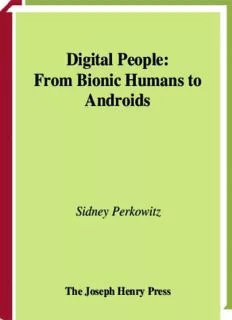
Digital People: From Bionic Humans to Androids PDF
Preview Digital People: From Bionic Humans to Androids
Digital People: From Bionic Humans to Androids Sidney Perkowitz The Joseph Henry Press by Sidney Perkowitz Joseph Henry Press Washington, D.C. Joseph Henry Press • 500 Fifth Street, N.W. • Washington, D.C. 20001 The Joseph Henry Press, an imprint of the National Academies Press, was created with the goal of making books on science, technology, and health more widely available to professionals and the public. Joseph Henry was one of the founders of the National Academy of Sciences and a leader in early American science. Any opinions, findings, conclusions, or recommendations expressed in this volume are those of the author and do not necessarily reflect the views of the National Academy of Sciences or its affiliated institutions. Library of Congress Cataloging-in-Publication Data Perkowitz, S. Digital people : from bionic humans to androids / Sidney Perkowitz. p. ; cm. Includes bibliographical references and index. ISBN 0-309-08987-5 (hardback) 1. Robotics. 2. Artificial intelligence. I. Title. TJ211.P44 2004 629.8’92—dc22 2004000049 Copyright 2004 by Sidney Perkowitz. All rights reserved. Printed in the United States of America. To Sandy and Mike, with love, . . . again Contents 1 Introduction: Androids All Around Us 1 PART I: ARTIFICIAL BEINGS: MEANING AND HISTORY 2 The Virtual History of Artificial Beings 17 3 The Real History of Artificial Beings 51 4 We Have Always Been Bionic 85 PART II: HOW FAR ALONG ARE WE? 5 Mind-Body Problems 105 6 Limbs, Movement, and Expression 123 vii viii CONTENTS 7 The Five Senses, and Beyond 147 8 Thinking, Emotion, and Self-Awareness 173 9 Frankenstein’s Creature or Commander Data? 199 Suggested Reading 220 Filmography 225 Acknowledgments 227 Index 229 1 Introduction: Androids All Around Us Y ou might not know it, but among us there exist artificial beings that are lifelike enough to give you goose bumps. If you had visited robot developer Rodney Brooks at MIT in the late 1990s, you would have met his Cog (short for “cognitive”) robot. Shaped vaguely like a human head and torso, and built more or less to human scale, Cog still looked alien and machinelike because it was made of girders and electronic components. Instead of eyes, video cameras located in its head fed visual information to its computer brain. But when I saw Cog’s intricate body language, I forgot its ma- chine appearance. Although it did not look like a person, it acted like one. Those sensors and computers, motors and metal supports kept its “eyes” in continual motion, scanning the scene for interesting events— just as our own brains and eyes do at an unconscious level. And when the door opened and a student walked in, Cog did what you or I would; it stopped scanning and turned toward the visitor. As Cog brought its gaze and (apparently) its full attention to bear on her, the action was so eerily human that it gave me a moment of hair-raising, gut-level understanding, for in that instant, Cog seemed fully alive and conscious. 1
Description: